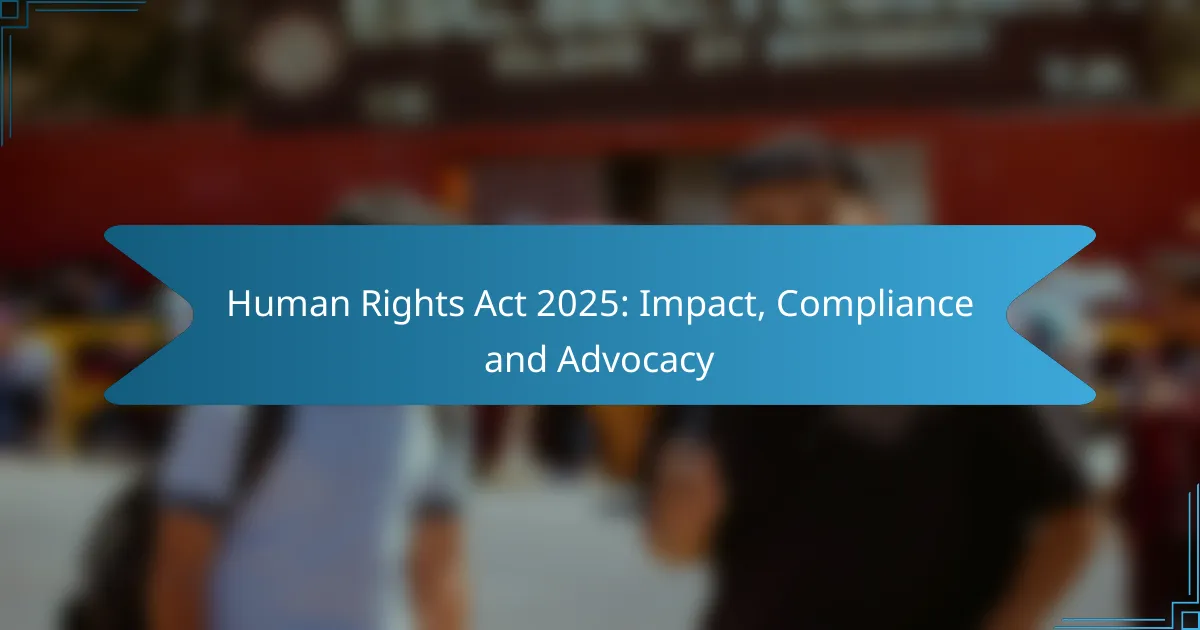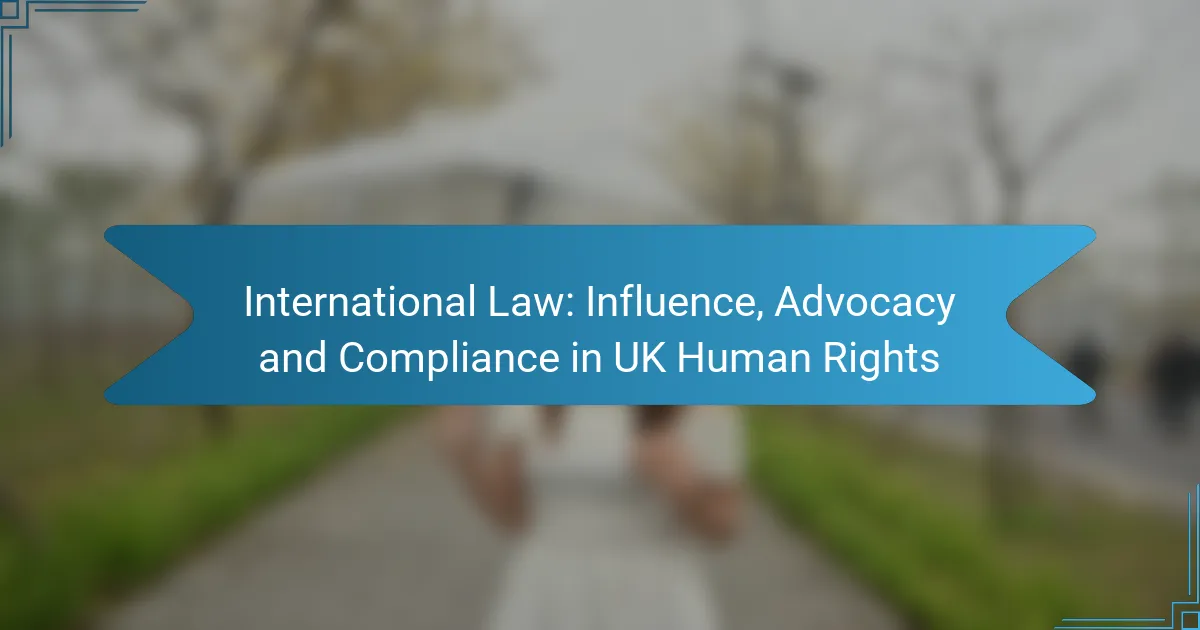The Human Rights Act 2025 represents a pivotal advancement in safeguarding individual rights within the UK, enhancing access to justice and accountability for all citizens. By establishing a comprehensive framework to address human rights violations and promote equality, it sets the stage for meaningful compliance and advocacy efforts aimed at fostering a culture of respect for human rights across various sectors.

What Are the Key Impacts of the Human Rights Act 2025 in the UK?
The Human Rights Act 2025 significantly enhances the protection of individual rights in the UK, ensuring that citizens have greater access to justice and accountability. This legislation aims to create a more robust framework for addressing human rights violations and promoting equality across various sectors.
Enhanced protection for individual rights
The Human Rights Act 2025 strengthens the safeguarding of personal freedoms and liberties, making it easier for individuals to assert their rights. This includes provisions that protect against discrimination, unlawful detention, and violations of privacy. Citizens now have clearer pathways to seek redress when their rights are infringed upon.
For example, individuals can challenge decisions made by public authorities more effectively, leading to a more transparent and fair process. The Act also emphasizes the importance of human dignity, which is central to its implementation.
Increased accountability for public authorities
With the introduction of the Human Rights Act 2025, public authorities are held to higher standards of accountability regarding their actions and decisions. This means that government bodies must ensure their policies and practices comply with human rights standards. Failure to do so can result in legal challenges and potential compensation claims.
Public authorities are now required to conduct impact assessments to evaluate how their actions affect individual rights. This proactive approach encourages a culture of respect for human rights within public services, fostering trust between citizens and the state.
Strengthened legal frameworks for discrimination cases
The Act enhances the legal frameworks surrounding discrimination, providing clearer definitions and stronger protections for marginalized groups. It addresses various forms of discrimination, including those based on race, gender, disability, and sexual orientation, ensuring that victims have better access to justice.
Legal practitioners now have more robust tools to challenge discriminatory practices, which can lead to significant changes in workplace policies and public services. This shift not only empowers individuals but also encourages organizations to adopt more inclusive practices to avoid legal repercussions.
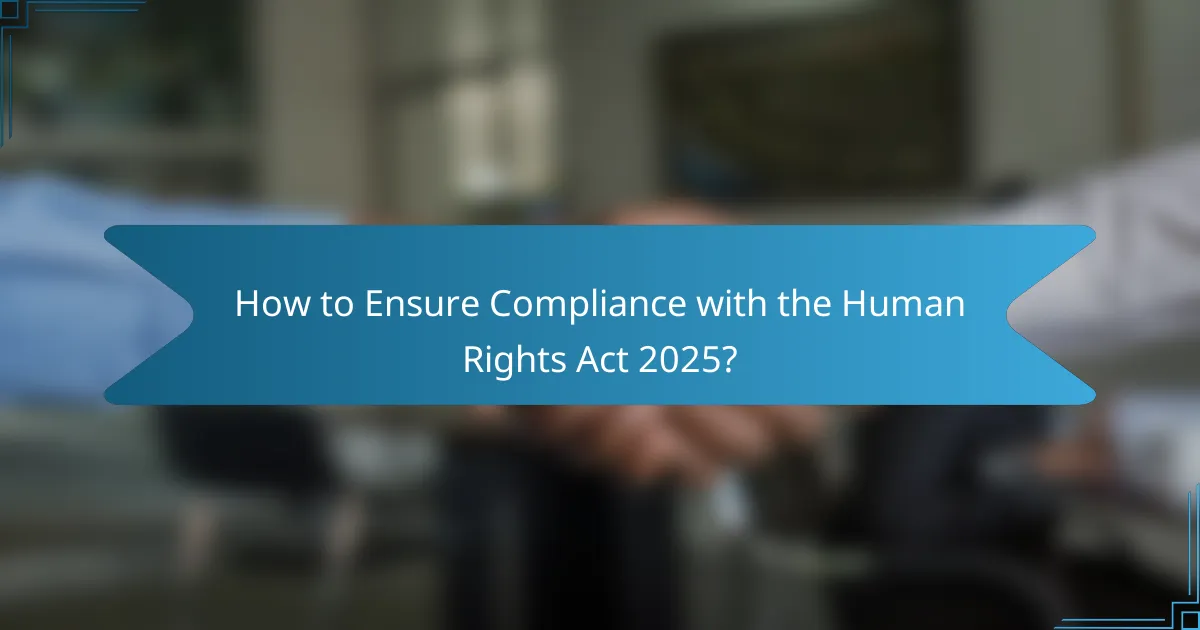
How to Ensure Compliance with the Human Rights Act 2025?
Ensuring compliance with the Human Rights Act 2025 involves implementing structured processes and practices that uphold human rights standards. Key strategies include regular training for public officials, conducting human rights impact assessments, and establishing compliance monitoring systems.
Regular training for public officials
Regular training for public officials is essential to ensure they understand and can effectively implement the Human Rights Act 2025. Training programs should cover the principles of human rights, relevant case studies, and practical applications in their daily duties.
Consider conducting training sessions at least annually, supplemented by refresher courses as needed. Engaging external experts can enhance the training experience and provide updated insights on human rights issues.
Implementation of human rights impact assessments
Implementing human rights impact assessments is crucial for evaluating the potential effects of policies and practices on human rights. These assessments should be integrated into the policy-making process to identify risks and mitigate negative impacts before they occur.
Public bodies should conduct these assessments regularly, especially for new initiatives or significant changes in existing policies. Utilizing a standardized framework can help streamline the assessment process and ensure consistency across evaluations.
Establishment of compliance monitoring systems
Establishing compliance monitoring systems allows organizations to track adherence to the Human Rights Act 2025 effectively. These systems should include mechanisms for reporting violations, regular audits, and feedback loops to improve practices continuously.
Consider using a combination of internal reviews and external audits to maintain objectivity. Engaging stakeholders, including civil society organizations, can provide valuable insights and enhance accountability in monitoring efforts.
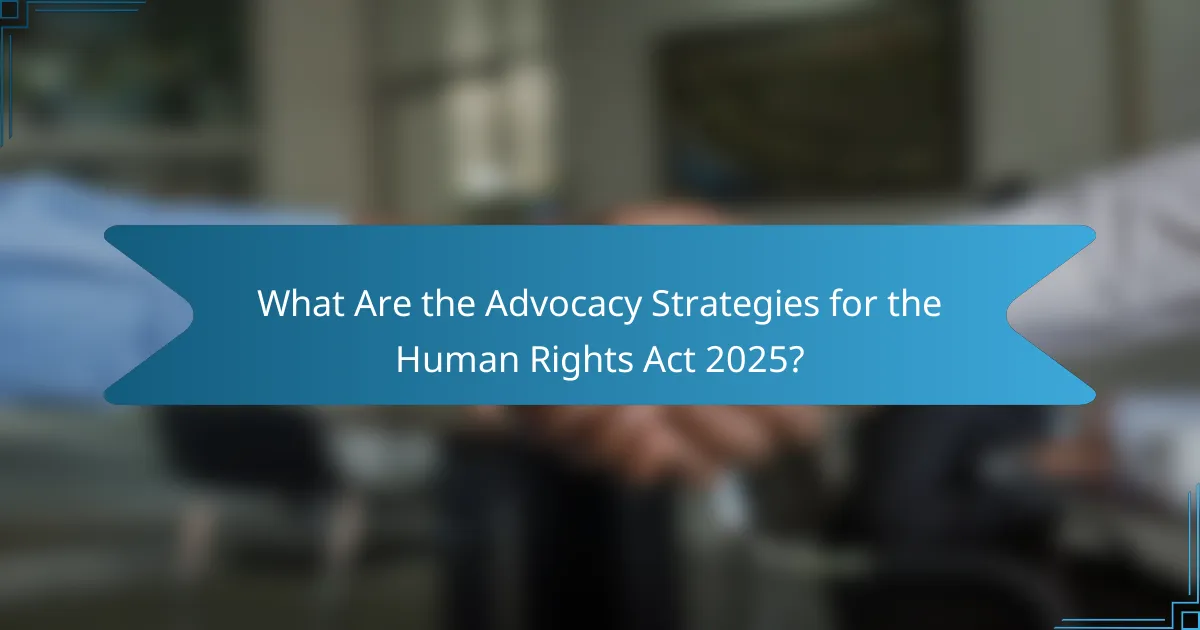
What Are the Advocacy Strategies for the Human Rights Act 2025?
Advocacy strategies for the Human Rights Act 2025 focus on mobilizing community support, fostering partnerships, and raising public awareness to ensure compliance and promote human rights. These strategies are essential for effective implementation and for holding authorities accountable.
Community engagement initiatives
Community engagement initiatives involve grassroots efforts to educate and involve local populations in human rights issues. These initiatives can include workshops, town hall meetings, and collaborative projects that encourage dialogue and participation.
Effective community engagement often requires tailoring approaches to specific demographics, ensuring that diverse voices are heard. For instance, involving youth through school programs can cultivate a new generation of advocates.
Collaborations with NGOs and civil society
Collaborating with non-governmental organizations (NGOs) and civil society groups is vital for amplifying advocacy efforts. These organizations often have established networks and expertise in human rights, which can enhance the effectiveness of campaigns.
Partnerships can take various forms, such as joint advocacy campaigns, resource sharing, and co-hosting events. Engaging with local NGOs can also help address specific regional issues, making advocacy more relevant and impactful.
Public awareness campaigns
Public awareness campaigns aim to inform the broader population about the Human Rights Act 2025 and its implications. These campaigns can utilize various media platforms, including social media, traditional advertising, and community events to reach diverse audiences.
Successful campaigns often feature clear messaging and relatable stories that resonate with the public. Utilizing local languages and cultural references can enhance engagement and understanding, making the message more accessible to all community members.
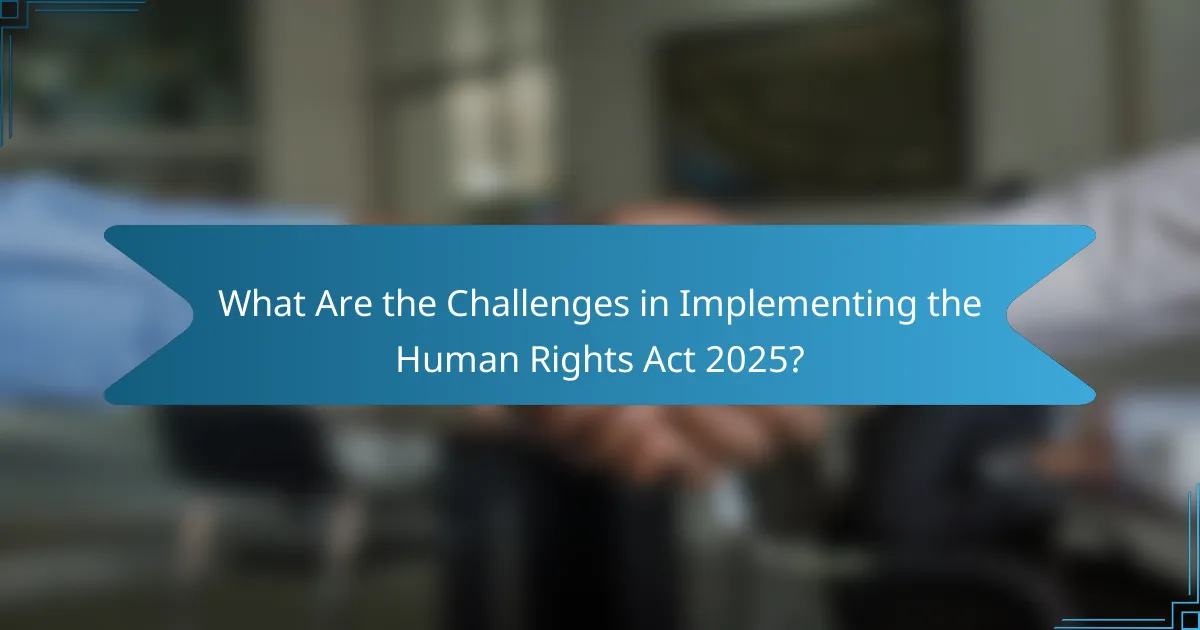
What Are the Challenges in Implementing the Human Rights Act 2025?
Implementing the Human Rights Act 2025 faces several significant challenges that can hinder its effectiveness. These challenges include political resistance, limited resources for enforcement, and widespread public misunderstanding of human rights principles.
Resistance from certain political factions
Political resistance can significantly impact the implementation of the Human Rights Act 2025. Some factions may oppose the Act due to ideological beliefs, fearing it could infringe on national sovereignty or limit governmental powers. This resistance can lead to legislative gridlock, delaying necessary reforms and undermining public trust in human rights protections.
To navigate this resistance, advocates should engage in dialogue with political opponents, emphasizing the benefits of human rights for all citizens. Building coalitions with like-minded organizations can also amplify the message and create a unified front in support of the Act.
Resource limitations for enforcement
Enforcement of the Human Rights Act 2025 requires adequate resources, including funding, personnel, and training. Many agencies may struggle with budget constraints, limiting their ability to effectively implement and monitor compliance with the Act. Insufficient resources can lead to inconsistent enforcement and a lack of accountability for human rights violations.
To address resource limitations, governments should prioritize funding for human rights initiatives and consider partnerships with non-governmental organizations (NGOs) that can provide additional support. Establishing clear guidelines for resource allocation can also help ensure that enforcement efforts are adequately supported.
Public misunderstanding of human rights
Public misunderstanding of human rights can pose a significant barrier to the successful implementation of the Human Rights Act 2025. Many individuals may lack awareness of their rights or the protections afforded by the Act, leading to apathy or resistance to its principles. Misconceptions about human rights can also fuel opposition from those who view them as threats to traditional values or societal norms.
To combat public misunderstanding, educational campaigns are essential. These campaigns should aim to clarify what human rights entail and how they benefit society as a whole. Engaging communities through workshops, social media, and public events can foster a better understanding and support for the Act.
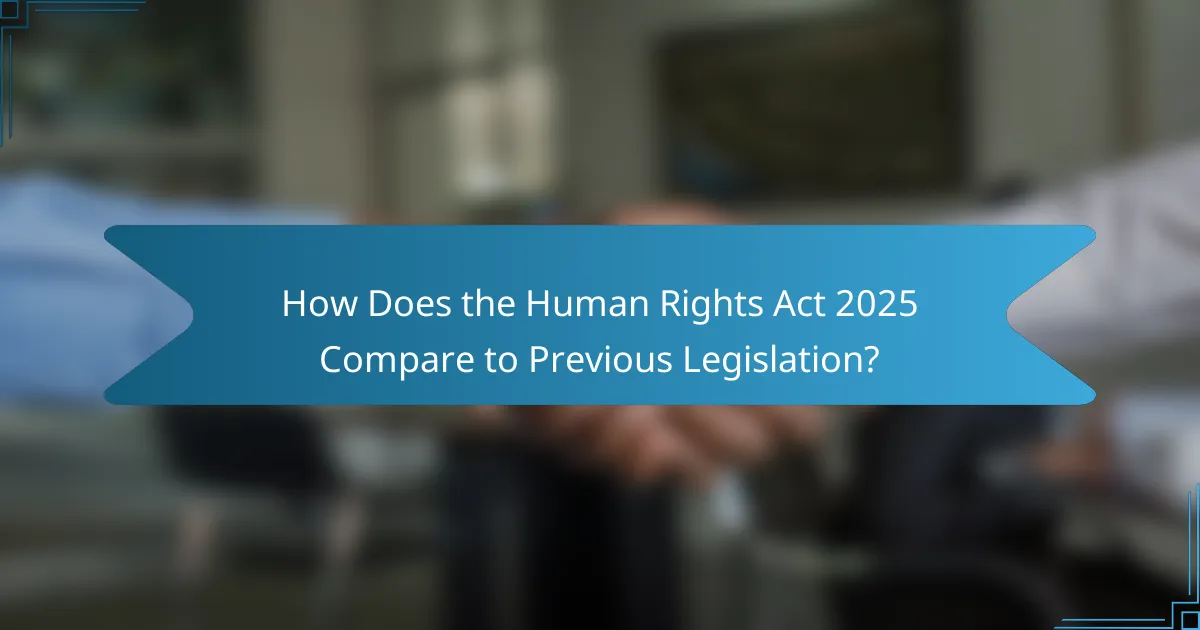
How Does the Human Rights Act 2025 Compare to Previous Legislation?
The Human Rights Act 2025 introduces significant changes compared to earlier legislation, particularly the Human Rights Act 1998. Key areas of improvement include enhanced legal recourse options, updated enforcement mechanisms, and a broader scope of rights protected.
Key differences from the Human Rights Act 1998
The Human Rights Act 2025 expands the range of rights and protections available to individuals, addressing gaps identified in the 1998 legislation. It emphasizes the importance of social and economic rights alongside civil and political rights, reflecting contemporary societal needs.
Additionally, the 2025 Act incorporates more robust provisions for vulnerable populations, ensuring that marginalized groups receive adequate protection under the law. This shift aims to create a more inclusive legal framework that better serves all citizens.
Improvements in legal recourse options
One of the notable advancements in the Human Rights Act 2025 is the enhancement of legal recourse options for individuals whose rights have been violated. The new legislation allows for more straightforward claims to be made in domestic courts, reducing the reliance on lengthy appeals to international bodies.
Moreover, individuals can now seek remedies for violations through a wider array of channels, including mediation and alternative dispute resolution methods. This flexibility aims to expedite justice and improve access to legal support for affected individuals.
Changes in enforcement mechanisms
The enforcement mechanisms under the Human Rights Act 2025 have been significantly strengthened, allowing for more effective oversight of compliance with human rights standards. This includes the establishment of independent oversight bodies tasked with monitoring and reporting on the implementation of the Act.
Furthermore, the 2025 Act introduces clearer penalties for non-compliance, ensuring that public authorities are held accountable for violations. This shift is designed to foster a culture of respect for human rights within governmental and institutional frameworks.
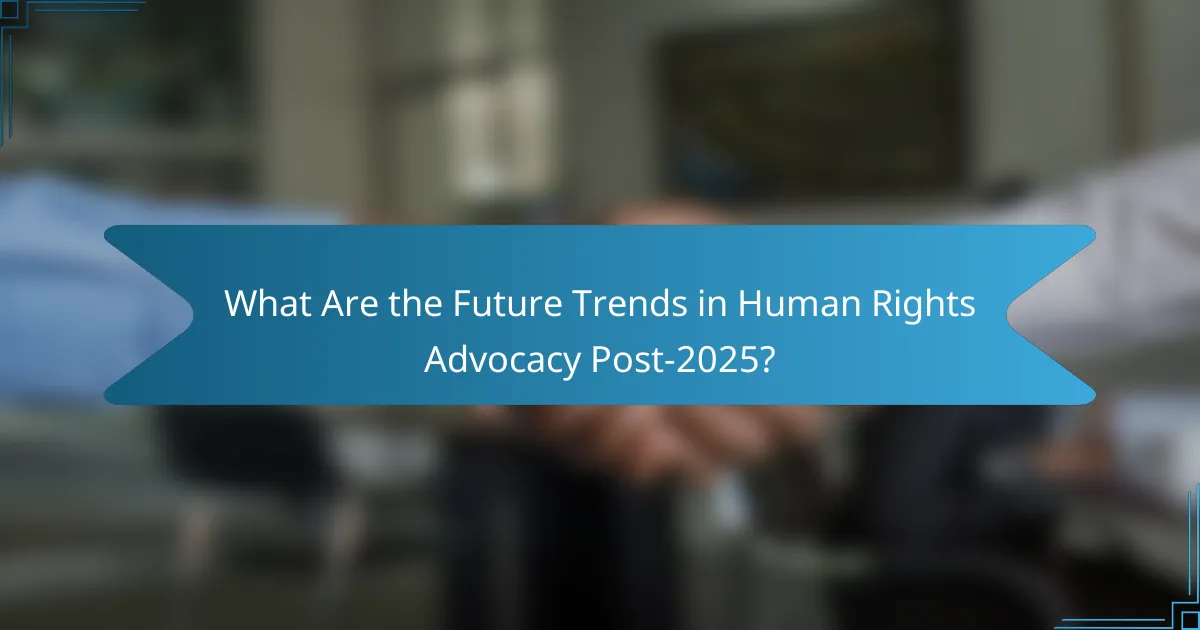
What Are the Future Trends in Human Rights Advocacy Post-2025?
Future trends in human rights advocacy post-2025 will likely emphasize digital rights, foster global coalitions, and integrate climate justice into existing frameworks. These shifts reflect the evolving landscape of human rights issues, driven by technological advancements and global interconnectivity.
Increased focus on digital rights
The rise of technology has made digital rights a crucial aspect of human rights advocacy. Issues such as data privacy, online freedom of expression, and access to information will gain prominence as more people rely on digital platforms for communication and commerce.
Advocates will need to address the challenges posed by surveillance, misinformation, and digital discrimination. Organizations may focus on creating guidelines and standards to protect individuals’ rights in the digital realm, ensuring that technology serves humanity rather than undermines it.
Emergence of global human rights coalitions
Post-2025, we can expect the formation of more global human rights coalitions that unite various stakeholders, including NGOs, governments, and private sectors. These coalitions will work collaboratively to tackle pressing human rights issues across borders, leveraging shared resources and expertise.
Such partnerships can enhance advocacy efforts, making them more effective in addressing systemic injustices. By pooling knowledge and strategies, these coalitions can amplify their voices and influence policy changes on a global scale.
Integration of climate justice into human rights frameworks
Climate justice will increasingly be recognized as a vital component of human rights advocacy. As the impacts of climate change disproportionately affect marginalized communities, integrating environmental concerns into human rights frameworks will be essential for equitable solutions.
Advocates will need to highlight the intersectionality of climate issues and human rights, pushing for policies that protect vulnerable populations while addressing environmental degradation. This may involve promoting sustainable practices and ensuring that climate policies respect and uphold human rights standards.
